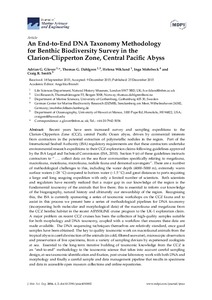| dc.contributor.author | Glover, Adrian G. | |
| dc.contributor.author | Dahlgren, Thomas G | |
| dc.contributor.author | Wiklund, Helena | |
| dc.contributor.author | Mohrbeck, Inga | |
| dc.contributor.author | Smith, Craig R. | |
| dc.coverage.spatial | Central Pacific Ocean | en_US |
| dc.coverage.spatial | Clarion Clipperton Zone | en_US |
| dc.date.accessioned | 2020-05-02T21:03:58Z | |
| dc.date.available | 2020-05-02T21:03:58Z | |
| dc.date.issued | 2016 | |
| dc.identifier.citation | Glover, A.G.; Dahlgren, T.G.; Wiklund, H.; Mohrbeck, I. and Smith, C.R. (2016) An End-to-End DNA Taxonomy Methodology for Benthic Biodiversity Survey in the Clarion-Clipperton Zone, Central Pacific Abyss. Journal of Marine Science and Engineering, 4: 2, 34pp. DOI: https://doi.org/10.3390/jmse4010002 | en_US |
| dc.identifier.uri | http://hdl.handle.net/11329/1320 | |
| dc.identifier.uri | http://dx.doi.org/10.25607/OBP-828 | |
| dc.description.abstract | Recent years have seen increased survey and sampling expeditions to the
Clarion-Clipperton Zone (CCZ), central Pacific Ocean abyss, driven by commercial interests
from contractors in the potential extraction of polymetallic nodules in the region. Part of the
International Seabed Authority (ISA) regulatory requirements are that these contractors undertake
environmental research expeditions to their CCZ exploration claims following guidelines approved
by the ISA Legal and Technical Commission (ISA, 2010). Section 9 (e) of these guidelines instructs
contractors to “ . . . collect data on the sea floor communities specifically relating to megafauna,
macrofauna, meiofauna, microfauna, nodule fauna and demersal scavengers”. There are a number
of methodological challenges to this, including the water depth (4000–5000 m), extremely warm
surface waters (~28 C) compared to bottom water (~1.5 C) and great distances to ports requiring
a large and long seagoing expedition with only a limited number of scientists. Both scientists
and regulators have recently realized that a major gap in our knowledge of the region is the
fundamental taxonomy of the animals that live there; this is essential to inform our knowledge
of the biogeography, natural history and ultimately our stewardship of the region. Recognising
this, the ISA is currently sponsoring a series of taxonomic workshops on the CCZ fauna and to
assist in this process we present here a series of methodological pipelines for DNA taxonomy
(incorporating both molecular and morphological data) of the macrofauna and megafauna from
the CCZ benthic habitat in the recent ABYSSLINE cruise program to the UK-1 exploration claim.
A major problem on recent CCZ cruises has been the collection of high-quality samples suitable
for both morphology and DNA taxonomy, coupled with a workflow that ensures these data are
made available. The DNA sequencing techniques themselves are relatively standard, once good
samples have been obtained. The key to quality taxonomic work on macrofaunal animals from the
tropical abyss is careful extraction of the animals (in cold, filtered seawater), microscopic observation
and preservation of live specimens, from a variety of sampling devices by experienced zoologists
at sea. Essential to the long-term iterative building of taxonomic knowledge from the CCZ is
an “end-to-end” methodology to the taxonomic science that takes into account careful sampling
design, at-sea taxonomic identification and fixation, post-cruise laboratory work with bothDNAand
morphology and finally a careful sample and data management pipeline that results in specimens
and data in accessible open museum collections and online repositories. | en_US |
| dc.language.iso | en | en_US |
| dc.rights | Attribution 4.0 International | * |
| dc.rights.uri | http://creativecommons.org/licenses/by/4.0/ | * |
| dc.subject.other | Macrofauna | en_US |
| dc.subject.other | Benthos | en_US |
| dc.subject.other | Abyssal | en_US |
| dc.subject.other | Polychaeta | en_US |
| dc.subject.other | Mollusca | en_US |
| dc.subject.other | Echinodermata | en_US |
| dc.subject.other | Box core | en_US |
| dc.subject.other | Epibenthic sledge | en_US |
| dc.title | An End-to-End DNA Taxonomy Methodology for Benthic Biodiversity Survey in the Clarion-Clipperton Zone, Central Pacific Abyss. | en_US |
| dc.type | Journal Contribution | en_US |
| dc.description.refereed | Refereed | en_US |
| dc.format.pagerange | 34pp. | en_US |
| dc.identifier.doi | https://doi.org/10.3390/jmse4010002 | |
| dc.subject.parameterDiscipline | Parameter Discipline::Biological oceanography::Other biological measurements | en_US |
| dc.subject.instrumentType | Instrument Type Vocabulary::benthos samplers | en_US |
| dc.bibliographicCitation.title | Journal of Marine Science and Engineering | en_US |
| dc.bibliographicCitation.volume | 4 | en_US |
| dc.bibliographicCitation.issue | Article 2 | en_US |
| dc.description.sdg | 14.A | en_US |
| dc.description.eov | Invertebrate abundance and distribution | en_US |
| dc.description.maturitylevel | TRL 9 Actual system "mission proven" through successful mission operations (ground or space) | en_US |
| dc.description.bptype | Manual (incl. handbook, guide, cookbook etc) | en_US |
| obps.contact.contactemail | a.glover@nhm.ac.uk | |
| obps.resourceurl.publisher | https://www.mdpi.com/2077-1312/4/1/2 | en_US |
 Repository of community practices in Ocean Research, Applications and Data/Information Management
Repository of community practices in Ocean Research, Applications and Data/Information Management

